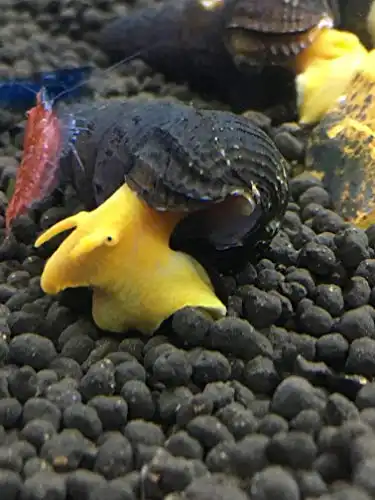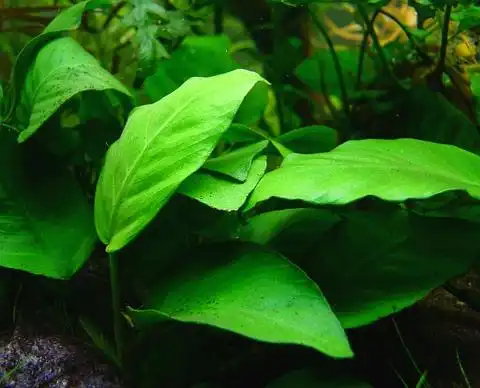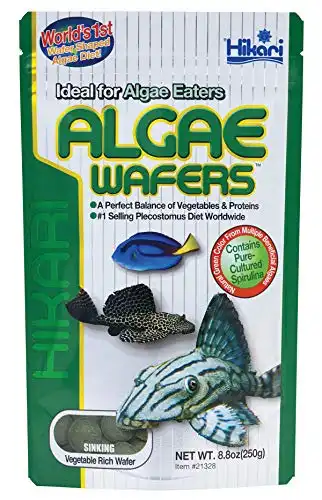Thank you for visiting! By the way… any links on this page that lead to products on Amazon and other stores/partners are affiliate links Aquarium Store Depot earns a commission if you make a purchase.
The Rabbit Snail is a unique freshwater species gaining popularity in pet stores recently. These captivating snails are quite beautiful with their vibrant colors and shapes. While also playing an important role in keeping aquariums clean, they consume algae and decaying plant materials! Let’s look closer at the world of these special creatures to understand more about them: where did they come from, what varieties exist out there, and how long do they typically live for? What size can we expect?
Key Takeaways
- Rabbit Snails are an interesting, colorful addition to any aquarium, with a long lifespan and many varieties.
- Provide them with a comfortable environment with substrate, greenery & stable water parameters for optimal health.
- Feed your Rabbit Snail a balanced diet of tank algae & treats while avoiding aggressive species as tank mates.
Species Overview
| Scientific Name | Tylomelania |
| Common Names | Rabbit Snail, Elephant Snail, Rabbit Snails, Sulawesi Snail, Poso Snails |
| Family | Pachychilidae |
| Origin | Sulawesi Indonesia |
| Diet | Omnivorous |
| Care Difficulty | Moderate |
| Activity | Mostly nocturnal |
| Life Expectancy | 1 – 3 Years |
| Temperament | Peaceful |
| Tank Level | All |
| Minimum Tank Size | 20 Gallons (75 Liters) |
| Water Temperature Range | 76-86°F (24-30°C) |
| Water Hardness | 2-15 dKH |
| pH Range | 7 – 7.5 |
| Filtration/Water Flow | All |
| Water Type | Freshwater |
| Breeding | Livebearer |
| Difficulty to Breed | Moderate |
| Compatibility | Community Tank |
| OK, for Planted Tanks? | With caution (eats some plants) |
Introduction
Elephant Snails, also known as Rabbit Snails, are a distinct snail species that aquarium hobbyists find attractive. They have a body and head structure that resembles rabbits or elephants, and they make great tankmates since they’re peaceful creatures that move slowly through the water.
These are unique looking freshwater snails that won’t overpopulate a tank. In this article, we will walk you through how to properly care for them, how to setup their tanks, and what tank mates work best for them.
Origins And Habitant
Rabbit Snails (also known as the Elephant Snail), native to the lakes and streams of Sulawesi in Indonesia, are a unique addition to any aquarium. Found inhabiting an environment abundant with life forms, these snails lend exotic beauty as well as intrigue when they become part of one’s home ecosystem. Wild-caught adults tend not to be too interested in brighter areas, but captively bred juveniles seem more flexible about different lighting conditions – so it’s recommended that shadowy spots be provided for them just in case!
Unique Features And Appearance
Rabbit Snails stand out from other freshwater snails with their distinctive appearance. This species is aptly named for its rabbit-like face and wrinkled skin that covers a captivating cone shaped shell that looks like a unicorn horn. The coloring of this special snail varies greatly – brown, dark, whitish or spotted are just some possibilities. Not to be overlooked either is how they use their ventral foot, which protrudes outside the shell as a method of locomotion!
A snail with a head that resembles a rabbit. Great for keeping the substrate tidy and clean. It can grow up to 4" inches in size
When considering all these unique features together, it’s easy to see why Rabbit Snails make such wonderful additions to aquariums. A major aspect of them one can’t ignore, though, is found through learning about – surprising enough – their shells! These shells resemble inverted unicorn horns and complement their colors.
Types Of Rabbit Snails
There are several rabbit snails available in the hobby. Each type has its own unique shell pattern and color. The yellow or golden rabbit snails are considered the most common.
- Yellow Poso
- Chocolate Rabbit Snails
- Black Rabbit Snails
- White spotted rabbit snails
- Golden Spotted
- Orange Rabbit Snail
- Red
All these will be sure to add diversity, as well as joy due to their contrasting colors, which make it easier for viewers to appreciate both the fish around them while admiring your chosen breed!
Lifespan
Rabbit snails are known for their long lifespan compared to other snails when in captivity, which could span anywhere from one to three years. The duration of its existence is affected by various elements such as tank size, water quality, and diet. Keeping a safe and healthy environment for these creatures is critical since happy animals usually live longer periods of time. If you notice any foul smell coming from your snail, it would be wise to take prompt action because that may indicate death or some other serious health issue occurring with them.
Average Size
Rabbit snails are truly remarkable in size compared to other snails. They will often reach up to 5 inches long and usually grow to 3 inch in length. Various factors like breed, diet, or environment can determine their final dimensions. These gentle giant snails bring great colors while not posing any danger to their tank mates. They do require larger tanks as a result.
Creating The Ideal Rabbit Snail Environment
Rabbit snail care is essential for providing a perfect home for your snails. Tank setup, water conditions, and substrate type are all crucial components that will ensure the well-being of these aquatic snails. With an optimal habitat created with your rabbit snails in mind, they can stay happy and healthy!
Let’s dive into the requirements and what to look out for.
Tank Requirements
When it comes to rabbit snails, a larger than is best to consider. Keep rabbit snails in a 20-gallon aquarium should be the minimum considered for these animals, with a larger one being preferred. Make sure there’s an effective lid in place to avoid any of them getting out accidentally. To protect water quality and your snail’s health, make sure you have both a filtration system and some sort of sponge prefilter which will safeguard them from coming into contact with filter tubes or other potential risks inside the tank environment.
Water Conditions And Temperature
Rabbit snails need alkaline water to remain in good health and strong shells. The temperature should stay consistent, usually hovering around 76-84 degrees Fahrenheit. pH should remain around 7 – 8.5, with high pH being preferred since that will naturally keep calcium high. A little hardness helps too.
It’s important for rabbit snail owners to provide them with an environment where both pH level and temperature are fairly stable since this is essential for keeping them healthy and safe from any shell deterioration issues.
As with all inverts, they are sensitive to copper and high nutrient levels. Test your water frequently and maintain the following parameters:
Substrate And Greenery
When creating a habitat for your rabbit snails, a good foundation is essential. For these particular snails, fine sand or gravel works best as their substrate, allowing them to burrow and scavenge around easily. In terms of vegetation, it’s recommended that you include both planted and floating varieties like Anubias, which not only look beautiful but also provide added shelter for the creatures in your aquarium. By crafting an environment with such additions, they will be more inclined to call this place home!
Anubias is hardy and more fish and inverts won't bother it. An excellent choice for beginners!
One thing to keep in mind with adult rabbit snails is that they are one of the few creatures you can keep in the aquarium that will try to eat Java Ferns.
Feeding
Rabbit snails will eat a variety of foods as they are omnivores. They require both animal and plant foods in their diet for optimal health. While they are great scavengers, they will not be able to get by with that activity. They will need to be given supplemented food in order to thrive
Rabbit snails enjoy a daily meal of tank algae food treats occasionally throughout the week. Soft plants, fish food, or shrimp pellets make great snacks! Algae wafers are an easy food stable to give them. You can also try blanched vegetables. Cucumbers and carrots work very well as options. Make sure to switch out foods to keep a balanced diet.
Algae wafers are a great way to directly feed your bottom feeding fish. They are especially effective for larger fish like plecos
Calcium Supplementation
A key element of the nutrition for rabbit snails is calcium, which helps sustain their shells’ robustness and bolsters their wellness. You can purchase foods online that contain calcium. Some of these are specialty foods that are made only for shrimp and snails. Having harder warm will help as well.
Tank Mates
The perfect tank mates for your rabbit snails can hugely benefit their wellbeing and happiness. These quiet animals are usually fine when living with other peaceful creatures such as fish, invertebrates, or fellow rabbit snails. Some species may not get along. Any aggressive type of fish should never reside in the same snail tank alongside assassin snails either. For those looking for ideal roommates for these docile critters, careful consideration must go into selecting suitable individuals from within a range of potentially compatible partners that could share this particular aquatic environment, the Rabbit Snail Tank!
Compatible Species
Rabbit snails can peacefully coexist with other community fish, invertebrates and even more of their own kind. An amazing fact about them is they do very well with Sulawesi shrimp. They form symbiotic relationships with these shrimp. It’s really fascinating to see these two species interact!
Other suitable mates for rabbit snails include:
- Mystery Snails
- Nerite Snails
- Pond snails
- Small schooling fish
- Livebearers
- Dwarf Gouramis
- Otocinclus Catfish
- Corydoras Catfish
- Other small freshwater shrimp like Cherry or Amano Shrimp
Species To Avoid
Some fish will see your Rabbit Snail as food and prey. Knowing this, here are some fish you will want to avoid:
- Freshwater puffers
- Loaches
- Large aggressive fish
- Assassin Snail (even adult Rabbit Snails are prone to getting ganged up on if the assassin snail is hungry enough)
- Crayfish
- Freshwater crabs
- Goldfish
To ensure everyone lives harmoniously together, it’s important to do sufficient research before adding any new tenants to cohabitate amongst the rabbit snail party!
Breeding
If you are planning to get into Rabbit Snail breeding, it is important to be aware of their breeding practices. Rabbit snails reproduce at a slow rate and give birth live, a unique characteristic among aquarium snails! They usually have one or two babies per reproduction round. Because of this slow reproduction, you are not as risk of having a talk overpopulated with them.
Once they reach sexual maturity (approximately 1.5 inches long or 1 year), how often the rabbits breed can depend on tank settings, namely water temperature. There is no way to differentiate male and female rabbit snails. If you plan on breeding them, the best way to succeed would be to purchase at least a group of 4. This will give you a good chance of getting at least 1 male and 1 female.
Let us explore more interesting rabbit snail mating and baby nurturing habits further!
Caring For Babies
The young of rabbit snails, commonly referred to as baby rabbit snails, are the cutest things around. They look like a reduced version of an adult snail with their small shell in place. They must be supplied food right after birth so that they can grow into strong and healthy adults. When the Rabbit Snail eggs are laid, a sack envelopes the new snail. The baby snail will develop in the egg sack until it is finally born! Such a site is most unique breeding process you will see among freshwater snails in the hobby (video source).
These cute little baby snails won’t receive direct care from their parents, but providing them with ideal tank parameters and proper sustenance will ensure that these babies live long, healthy lives.
Common Health Concerns
When it comes to health matters, rabbit snails are not immune either. Commonly they suffer from leeches which attach themselves to the inner part of their shell and feed off them causing damages. Shell-related issues can also be a nuisance for these creatures, but with proper diet and clean water conditions shells have been known to heal on their own over time.
Frequently Asked Questions
Do rabbit snails clean freshwater tanks?
Rabbit snails are ideal for keeping aquariums clean since they graze on algae and biofilm that accumulates along the surface. They also help keep the substrate clear by burrowing through it, feeding off any decomposing material. While they are good scavengers and clean animals, they are not compatible with several types of plants. Make sure you do your research on the plants you are planning to keep as your rabbit snail may decide to snack on them!
Do rabbit snails like sand?
Rabbits are very fond of sandy substrates as they can easily tunnel through it in search of food. They also enjoy other types of substrate, such as aquasoil and river gravel. All these materials make life more comfortable for rabbit snails when looking to feed themselves well. Their preferred substrate is sand with finer gravel or aquasoil being their second preference.
Do rabbit snails have live babies?
Rabbit Snails make a wonderful addition to any aquarium, as they are peaceful creatures. Every 4-6 weeks, the female will release an egg sack with 1 or 2 fully formed baby snails inside. This creamy white pouch is released into the water, and shortly after that, babies emerge, ready to start munching away at anything in sight!
Raising these snail youngsters requires very little effort since once they come out of their egg sacks all it takes for them to grow big and strong is just food available in plenty! Because of their low production rates, their numbers are easy to control in an aquarium setting.
Are rabbit snails easy to keep?
These hardy creatures, Rabbit Snails, are very easy to take care of when provided in the right environment in a well-established aquarium. Having suitable substrate and water parameters is key for maintaining their healthiness and longevity.
What do rabbit snails eat?
Rabbit snails are an omnivorous species that consume soft algae, fish or shrimp food as well as decaying vegetation. For feeding, they enjoy algae wafers, specialty made snail foods, and blanched vegetables.
Closing Thoughts
Rabbit snails are a stunning addition to any community aquarium, with their incredible colors and beneficial features. Experienced or novice aquarists alike can discover the wonders of owning these gentle giants that provide an ecologically balanced environment for your community tank. Taking care of them is simple. Just ensure you create an appropriate habitat, offer suitable food, and understand some basics about rabbit snail behavior so they can thrive in your home aquarium! With all these traits combined, having one of those aquatic rainbows within reach will undoubtedly make for a delightful experience full of fascination & joy.
- About the Author
- Latest Posts
I’m thrilled that you found Aquarium Store Depot! Here you’ll find information on fish, aquariums, and all things aquatics related. I’m a hobbyist (being doing this since I was 11) and here to help other hobbyists thrive with their aquariums! I adhere to a high quality Editorial Process and Review products with real life field usage and practical analysis.








